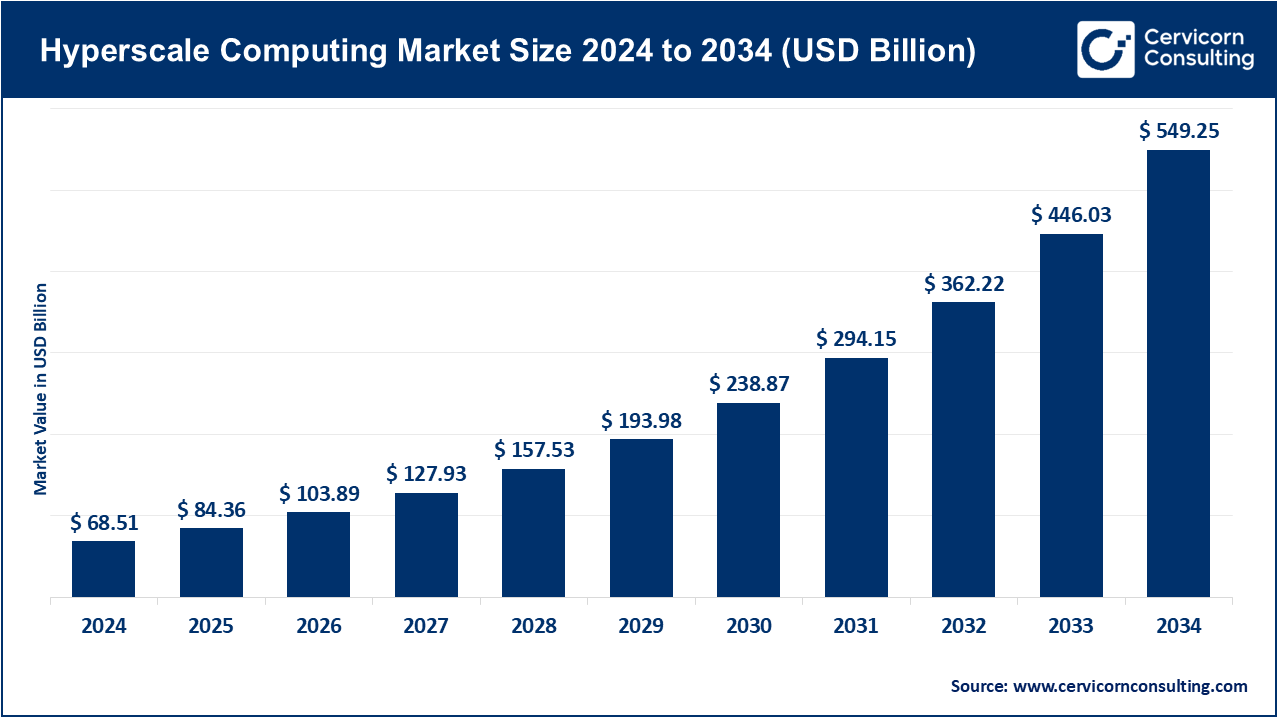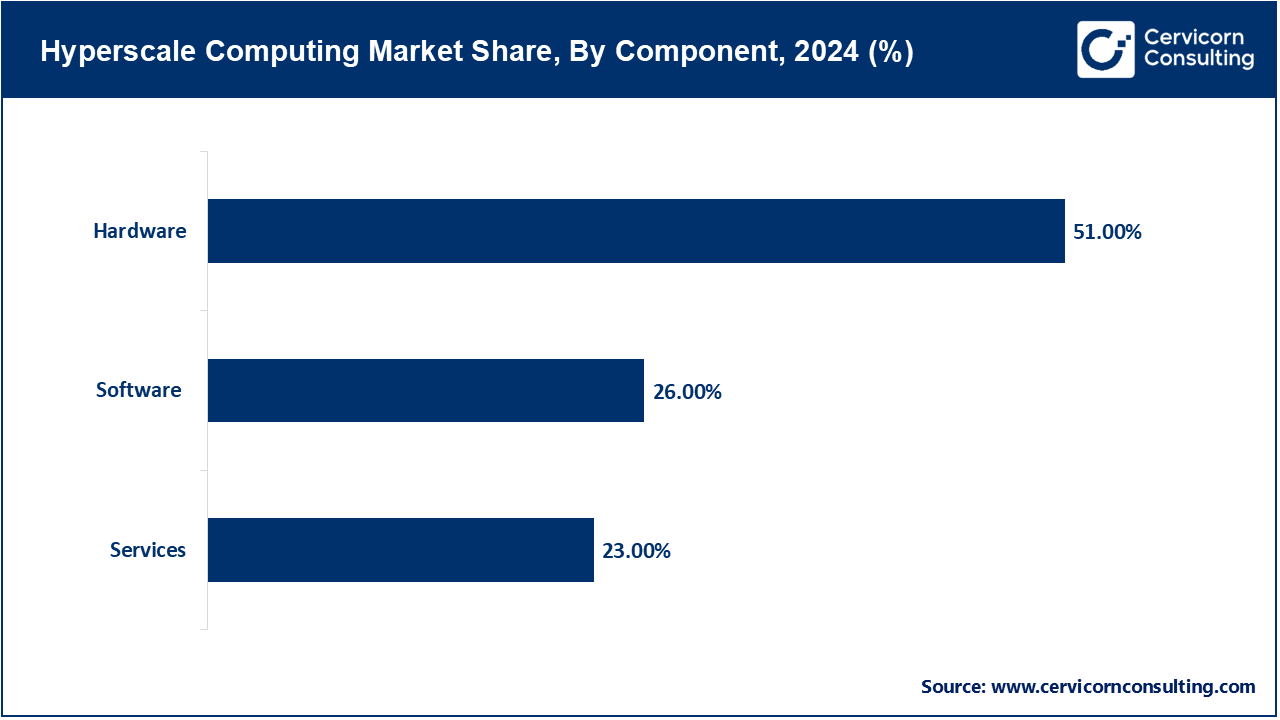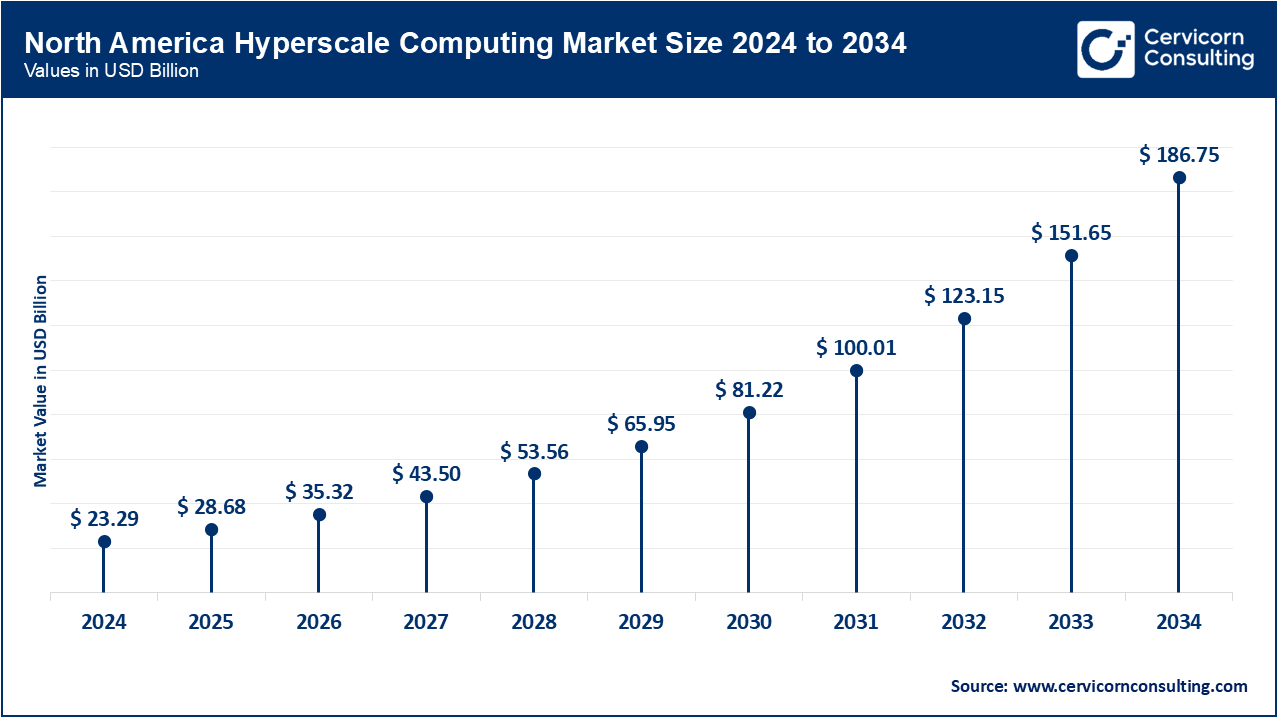The global hyperscale computing market size was estimated at USD 68.51 billion in 2024 and is expected to surpass around USD 549.25 billion by 2034, growing at a compound annual growth rate (CAGR) of 23.14% over the forecast period from 2025 to 2034.
The use of hyperscale computing infrastructure has significantly grown from cloud services due to its flexibility and cost-efficiency. Cloud service providers are now able to utilize their resources with ease due to the backbone that hyperscale infrastructure provides, which allows for the seamless switch to virtual systems. As businesses continue with their digital transformation initiatives, getting new cloud-based applications, managing data streams, and deploying artificial intelligence (AI) models is increasingly predicated on the usage of cloud infrastructure. In 2024, the cloud services market will reach 94% adoption from enterprises, with 67% shifting towards hybrid or multi-cloud implementations for improved flexibility and lower costs. AWS, Microsoft Azure, and Google Cloud, with 31%, 25%, and 11% market shares, respectively, public clouds run over 1,000 hyperscale data centers servicing the finance, healthcare, and other industries on a global scale. SaaS applications are projected to account for 70% of public cloud revenue expanding with Salesforce and Zoom servicing tens of millions of users concurrently. Hyperscale infrastructure holds significance in the AI industry as well, servicing workloads like training GPT-4, which demands thousands of GPUs and multi-petabyte storage at constant access.

What is hyperscale computing?
Hyperscale computing refers to the design and operation of IT environments that can expand and contract seamlessly to match workload fluctuations. Such systems emphasize a distributed model wherein tens of thousands of physical and abstract servers operate under a common orchestration framework to deliver economical, data-rich processing, extensive object storage, and resilient, high-bandwidth networking. This model underpins cloud computing and big data analytics as well as Artificial Intelligence (AI) and Internet of Things (IoT) ecosystems. Cloud adoption, enterprise-wide digital transformation, and shifts within the organization to process real-time data at an unprecedented scale are the primary drivers of this change. Organizations in banking, retail, healthcare, media, and other industries are utilizing hyperscale technologies to enable mission-critical applications, improve operational efficiencies, elevate user satisfaction, and lower IT expenditures.
IT Spending in USD Billion, 2024
| Country | IT Spending, USD Billion, 2024 |
| United States | 1350 |
| China | 465 |
| Japan | 203 |
| Germany | 149 |
| United Kingdom | 135 |
Hardware: Hardware serves as the backbone of hyperscale computing infrastructure as it supports massive workloads, high-performance computing technologies, and rapid data transfers. Custom servers and interconnects, SSD arrays and NVMe storages, cooling technologies, as well as GPUs and CPUs of x86 or ARM architectures are key components. Hyper scale data centers have a keen emphasis towards performance per watt and energy efficiency. Also, the density of the computing units motivates the vendors to come up with innovations in regard to liquid cooling, modular racks, and energy efficient processors. Amazon and Google are already taking great leaps to identify and solve these problems, as their TPU and Graviton3 processors show a 15–30% and 25% increase in performance, respectively, in comparison to previous models.

Software: In hyperscale environments, software is defined as automation apparatus, resource management systems, hypervisors, container runtimes (Docker, CRI-O), and orchestration platforms. Within AI operations, firms leveraging TensorFlow and PyTorch stand out, and PyTorch’s adoption in corporate enterprises has grown from 36% in 2020 to more than 75% in 2024, mostly because of its ease in transitioning from research to production. It also encompasses distributed file systems such as Hadoop HDFS, AI frameworks including TensorFlow and PyTorch, as well as control planes for multi-cloud orchestration. Software systems also determine the virtualization, automation, and monitoring efficiency of a given hyperscale infrastructure. The backbone of hyperscale automation relies on software such as Kubernetes, OpenStack, and other hyperscaler proprietary platforms.
Services: Professional services include deployment consulting, system integration, performance tuning, security auditing, and management services. These services are essential for monitoring system usage, mitigating system downtime, and improving cyber defense systems.
Based on enterprise size, the market is classified into large enterprises and SMEs. The large enterprises segment has dominated the market in 2024.
Hyperscale Computing Market Revenue Share, By Enterprise Size, 2024 (%)
| Enterprise Size | Revenue Share, 2024 (%) |
| Large Enterprises | 70.40% |
| SMEs | 29.60% |
Cloud Providers: Cloud providers constitute the primary builders and utilizers of hyperscale infrastructure. Companies like AWS, Google Cloud, Microsoft Azure, Oracle Cloud, and Alibaba Cloud operate thousands of hyperscale data centers around the world. AWS alone holds a 32% share of the global cloud market, with Azure and Google Cloud coming in at 23% and 11%, respectively, with all three serving millions of clients in diverse sectors. Their expansion increases the need for advanced networking, AI infrastructure, and global content delivery. To support millions of customers, run massive virtual workloads, and dynamically scale services, cloud providers adopt hyperscale computing. Innovations developed internally include custom silicon (TPUs, Graviton), zonal fault tolerance, and energy-efficient cooling.
Government & Defence: Governments deploy hyperscale computing for surveillance, intelligence processing, e-governance, and scientific simulations. Defence agencies utilize high-speed computing for real-time analytics, cybersecurity operations, cryptographic modeling, and simulations of various battle scenarios. Due to data sovereignty and sensitivity, many agencies resort to on-premise or government-private deployments, like the DoD's Joint Warfighting Cloud Capability (JWCC). Take, for instance, the multi cloud contract from the U.S. Defense Department for JWCC, awarded in 2022, with AWS, Microsoft, Google, and Oracle. It’s a $9 billion multi-cloud contract to furnish secure, high-capacity compute resources across classified, secret, and unclassified domains. In the same fashion, the EU is spending €2 billion with AWS to develop exascale systems for AI-driven research, climate modeling, and defense.
BFSI: Hyperscale Technology is used by banks and insurers for fraud detection, customer analytics, algorithmic trading, real-time risk analysis, as well as for post-event compliance reporting. Cases such as these and many others within the BFSI sector necessitate the use of low-latency, always-on, and high-compliance systems which in turn fuels the need for hyperscale-grade computing.
Others: Complementary to public cloud environments, hyperscale paradigms now permeate education—exemplified by asynchronous MOOC infrastructures—advanced manufacturing that employs real-time analytics of digital twins and predictive maintenance, retail sectors utilizing microservices for demand forecasting and personalized recommendation engines, and media houses delivering adaptive OTT streaming and latency-sensitive video rendering.
On-Premise: The on-premise deployment model is mostly utilized by tech giants, operations telecom, or major financial players who desire full infrastructure control. Customers in this category tend to prioritize ultra-low latency, regulatory compliance, and cost optimization over time. On-Premise hyperscale is expensive to establish, but enhances privacy and data localization thru tailored workloads. On-premise hyperscale campuses are built by Meta (formerly known as Facebook), Apple, and Baidu. These projects do face some obstacles like a lack of skilled workers, long setup times of 24–36 months, and overall running costs like cooling and energy management. One large scale site has the potential to consume enough energy to power 80 thousand U.S. homes in a year.
Hyperscale Computing Market Revenue Share, By Deployment Type, 2024 (%)
| Deployment Type | Revenue Share, 2024 (%) |
| On-Premise | 40% |
| Cloud-Based | 60% |
Cloud-Based: In 2024, cloud-based deployments made up more than 70% of all hyperscale computing revenue, supplemented by the need for flexibility, global access, pay-as-you-go pricing, and automatic backup systems. Public cloud vendors are used by all scales of businesses to access hyperscale capabilities without necessitating physical infrastructure. Important factors also include the ability to scale, geographical reach, pay-as-you-go pricing, and backup options. Global SaaS distribution, intensive workloads, big data analytics, and AI model training all benefit from this structure.

The U.S. dominated region holds the largest number of hyper-scaled computing. AWS, Microsoft, Google, and Meta, outputting massive workloads, lead the construction of new centers expanding the region. According to recent estimates, North America leads the market and has over 34% share of operational hyperscale data centers worldwide as of 2024. The United States also leads in AI 5G rollout developments and clean energy-based data center infrastructure. The region’s policies, workforce, and mature connectivity infrastructure foster innovation and investment in hyperscale technologies. Due to its climate and renewable energy resources, Canada is emerging as a secondary hub. North America has also high cloud adoption in BFSI, government, and healthcare sectors.
The Asia-Pacific (APAC) region is currently the fastest-growing market, with leaders including South Korea, Australia, India, and China, alongside advanced technology hubs such as Japan and rapidly digitalizing nations like Indonesia and Vietnam. The region is expected to have large-scale investments in smart cities and 5G infrastructure, further digitizing the nation, driving a 20-25% CAGR over the forecast period. In addition to the rapid growth of the region with smart cities and digitization programs, there is also a focus on local cloud suppliers cut government and policy backed controlling frameworks like India’s data localization policies. Strong support from the government along with the rising adoption of the digital economy fuels increased internet accessibility make for a unique mix of growth factors.
Hyperscale Computing Market Revenue Share, By Region, 2024 (%)
| Region | Revenue Share, 2024 (%) |
| North America | 34% |
| Europe | 30% |
| Asia-Pacific | 26% |
| LAMEA | 10% |
Europe is Known for its strict regulatory supervision, the region has witnessed GDPR shape hyperscale operations greatly. Europe possesses strong digital infrastructure, especially Germany, UK, France and the Nordics. There is an increasing attention to green hyperscale data centers that utilize renewable energy sources and liquid cooling systems. Projects like Gaia-X are intended to construct sovereign European cloud alternatives. Adoption is strong in automotive, manufacturing, BFSI, and health tech. Digital sovereignty and energy concerns are leading to innovative solutions in the region's hyperscale architecture. The explosive growth in hyperscale computing is primarily driven by big data analytics and artificial intelligence (AI). These solutions call for exceptional processing potential, real-time scalability, memory, and many more features, all of which are obtainable within hyperscale computing environments. The European hyperscale market is expected to operate at a CAGR of 18% through 2030, fueled by AI applications for deep learning, autonomous systems, medical systems, and fraud detection which require massive compute density and need to be scaled in real-time.
LAMEA serves as a strategically located frontier market. It also offers unutilized potential in areas with increasing digital penetration and favorable government policies. In Latin America, the region's hyperscale leaders are Mexico and Brazil, with Brazil dominating the region with over 40% of their hyperscale capacity. Mexico and Brazil are supported by booming eCommerce, digitalized retail, streaming, and fintech. Recently, São Paulo's AWS cloud region expansion was announced which comes along with a $1.35 billion investment. Likewise, Microsoft is strengthening their data center presence with $1.1 billion investment in Mexico. The Middle East centres efforts in the United Arab Emirates and Saudi Arabia, which are funding hyper-scale data-centre clusters to support smart-city initiatives.
Market Segmentation
By Component
By Deployment Type
By Enterprise Size
By Application
By End-User
By Region
Chapter 1. Market Introduction and Overview
1.1 Market Definition and Scope
1.1.1 Overview of Hyperscale Computing
1.1.2 Scope of the Study
1.1.3 Research Timeframe
1.2 Research Methodology and Approach
1.2.1 Methodology Overview
1.2.2 Data Sources and Validation
1.2.3 Key Assumptions and Limitations
Chapter 2. Executive Summary
2.1 Market Highlights and Snapshot
2.2 Key Insights by Segments
2.2.1 By Component Overview
2.2.2 By Deployment Type Overview
2.2.3 By Enterprise Size Overview
2.2.4 By Application Overview
2.2.5 By End User Overview
2.3 Competitive Overview
Chapter 3. Global Impact Analysis
3.1 Russia-Ukraine Conflict: Global Market Implications
3.2 Regulatory and Policy Changes Impacting Global Markets
Chapter 4. Market Dynamics and Trends
4.1 Market Dynamics
4.1.1 Market Drivers
4.1.1.1 Surge in Cloud Services and Data Explosion Across Industries
4.1.1.2 Growing Demand for High-Performance Computing in AI, IoT, and Analytics
4.1.2 Market Restraints
4.1.2.1 High Capital Expenditure and Operational Costs
4.1.2.2 Growing Data Privacy, Security, and Regulatory Challenges
4.1.3 Market Challenges
4.1.3.1 Energy Consumption and Sustainability Concerns
4.1.3.2 Infrastructure Complexity and Skill Shortages
4.1.4 Market Opportunities
4.1.4.1 Rapid Growth in Edge Computing and IoT Integration
4.1.4.2 Digital Transformation Across Emerging Economies
4.2 Market Trends
Chapter 5. Premium Insights and Analysis
5.1 Global Hyperscale Computing Market Dynamics, Impact Analysis
5.2 Porter’s Five Forces Analysis
5.2.1 Bargaining Power of Suppliers
5.2.2 Bargaining Power of Buyers
5.2.3 Threat of Substitute Products
5.2.4 Rivalry among Existing Firms
5.2.5 Threat of New Entrants
5.3 PESTEL Analysis
5.4 Value Chain Analysis
5.5 Product Pricing Analysis
5.6 Vendor Landscape
5.6.1 List of Buyers
5.6.2 List of Suppliers
Chapter 6. Hyperscale Computing Market, By Component
6.1 Global Hyperscale Computing Market Snapshot, By Component
6.1.1 Market Revenue (($Billion) and Growth Rate (%), 2022-2034
6.1.1.1 Hardware
6.1.1.2 Software
6.1.1.3 Services
Chapter 7. Hyperscale Computing Market, By Deployment Type
7.1 Global Hyperscale Computing Market Snapshot, By Deployment Type
7.1.1 Market Revenue (($Billion) and Growth Rate (%), 2022-2034
7.1.1.1 On-Premise
7.1.1.2 Cloud-Based
Chapter 8. Hyperscale Computing Market, By Enterprise Size
8.1 Global Hyperscale Computing Market Snapshot, By Enterprise Size
8.1.1 Market Revenue (($Billion) and Growth Rate (%), 2022-2034
8.1.1.1 Large Enterprises
8.1.1.2 SMEs
Chapter 9. Hyperscale Computing Market, By Application
9.1 Global Hyperscale Computing Market Snapshot, By Application
9.1.1 Market Revenue (($Billion) and Growth Rate (%), 2022-2034
9.1.1.1 Cloud Computing
9.1.1.2 Big Data
9.1.1.3 IoT
9.1.1.4 Others
Chapter 10. Hyperscale Computing Market, By End-User
10.1 Global Hyperscale Computing Market Snapshot, By End-User
10.1.1 Market Revenue (($Billion) and Growth Rate (%), 2022-2034
10.1.1.1 Cloud Providers
10.1.1.2 Government & Defence
10.1.1.3 BFSI
10.1.1.4 Retail & E-commerce
10.1.1.5 Healthcare
10.1.1.6 Others
Chapter 11. Hyperscale Computing Market, By Region
11.1 Overview
11.2 Hyperscale Computing Market Revenue Share, By Region 2024 (%)
11.3 Global Hyperscale Computing Market, By Region
11.3.1 Market Size and Forecast
11.4 North America
11.4.1 North America Hyperscale Computing Market Revenue, 2022-2034 ($Billion)
11.4.2 Market Size and Forecast
11.4.3 North America Hyperscale Computing Market, By Country
11.4.4 U.S.
11.4.4.1 U.S. Hyperscale Computing Market Revenue, 2022-2034 ($Billion)
11.4.4.2 Market Size and Forecast
11.4.4.3 U.S. Market Segmental Analysis
11.4.5 Canada
11.4.5.1 Canada Hyperscale Computing Market Revenue, 2022-2034 ($Billion)
11.4.5.2 Market Size and Forecast
11.4.5.3 Canada Market Segmental Analysis
11.4.6 Mexico
11.4.6.1 Mexico Hyperscale Computing Market Revenue, 2022-2034 ($Billion)
11.4.6.2 Market Size and Forecast
11.4.6.3 Mexico Market Segmental Analysis
11.5 Europe
11.5.1 Europe Hyperscale Computing Market Revenue, 2022-2034 ($Billion)
11.5.2 Market Size and Forecast
11.5.3 Europe Hyperscale Computing Market, By Country
11.5.4 UK
11.5.4.1 UK Hyperscale Computing Market Revenue, 2022-2034 ($Billion)
11.5.4.2 Market Size and Forecast
11.5.4.3 UKMarket Segmental Analysis
11.5.5 France
11.5.5.1 France Hyperscale Computing Market Revenue, 2022-2034 ($Billion)
11.5.5.2 Market Size and Forecast
11.5.5.3 FranceMarket Segmental Analysis
11.5.6 Germany
11.5.6.1 Germany Hyperscale Computing Market Revenue, 2022-2034 ($Billion)
11.5.6.2 Market Size and Forecast
11.5.6.3 GermanyMarket Segmental Analysis
11.5.7 Rest of Europe
11.5.7.1 Rest of Europe Hyperscale Computing Market Revenue, 2022-2034 ($Billion)
11.5.7.2 Market Size and Forecast
11.5.7.3 Rest of EuropeMarket Segmental Analysis
11.6 Asia Pacific
11.6.1 Asia Pacific Hyperscale Computing Market Revenue, 2022-2034 ($Billion)
11.6.2 Market Size and Forecast
11.6.3 Asia Pacific Hyperscale Computing Market, By Country
11.6.4 China
11.6.4.1 China Hyperscale Computing Market Revenue, 2022-2034 ($Billion)
11.6.4.2 Market Size and Forecast
11.6.4.3 ChinaMarket Segmental Analysis
11.6.5 Japan
11.6.5.1 Japan Hyperscale Computing Market Revenue, 2022-2034 ($Billion)
11.6.5.2 Market Size and Forecast
11.6.5.3 JapanMarket Segmental Analysis
11.6.6 India
11.6.6.1 India Hyperscale Computing Market Revenue, 2022-2034 ($Billion)
11.6.6.2 Market Size and Forecast
11.6.6.3 IndiaMarket Segmental Analysis
11.6.7 Australia
11.6.7.1 Australia Hyperscale Computing Market Revenue, 2022-2034 ($Billion)
11.6.7.2 Market Size and Forecast
11.6.7.3 AustraliaMarket Segmental Analysis
11.6.8 Rest of Asia Pacific
11.6.8.1 Rest of Asia Pacific Hyperscale Computing Market Revenue, 2022-2034 ($Billion)
11.6.8.2 Market Size and Forecast
11.6.8.3 Rest of Asia PacificMarket Segmental Analysis
11.7 LAMEA
11.7.1 LAMEA Hyperscale Computing Market Revenue, 2022-2034 ($Billion)
11.7.2 Market Size and Forecast
11.7.3 LAMEA Hyperscale Computing Market, By Country
11.7.4 GCC
11.7.4.1 GCC Hyperscale Computing Market Revenue, 2022-2034 ($Billion)
11.7.4.2 Market Size and Forecast
11.7.4.3 GCCMarket Segmental Analysis
11.7.5 Africa
11.7.5.1 Africa Hyperscale Computing Market Revenue, 2022-2034 ($Billion)
11.7.5.2 Market Size and Forecast
11.7.5.3 AfricaMarket Segmental Analysis
11.7.6 Brazil
11.7.6.1 Brazil Hyperscale Computing Market Revenue, 2022-2034 ($Billion)
11.7.6.2 Market Size and Forecast
11.7.6.3 BrazilMarket Segmental Analysis
11.7.7 Rest of LAMEA
11.7.7.1 Rest of LAMEA Hyperscale Computing Market Revenue, 2022-2034 ($Billion)
11.7.7.2 Market Size and Forecast
11.7.7.3 Rest of LAMEAMarket Segmental Analysis
Chapter 12. Competitive Landscape
12.1 Competitor Strategic Analysis
12.1.1 Top Player Positioning/Market Share Analysis
12.1.2 Top Winning Strategies, By Company, 2022-2024
12.1.3 Competitive Analysis By Revenue, 2022-2024
12.2 Recent Developments by the Market Contributors (2024)
Chapter 13. Company Profiles
13.1 Amazon Web Services
13.1.1 Company Snapshot
13.1.2 Company and Business Overview
13.1.3 Financial KPIs
13.1.4 Product/Service Portfolio
13.1.5 Strategic Growth
13.1.6 Global Footprints
13.1.7 Recent Development
13.1.8 SWOT Analysis
13.2 Microsoft Corporation
13.3 Google LLC
13.4 Oracle Corporation
13.5 IBM Corporation
13.6 Alibaba Cloud
13.7 Tencent Cloud
13.8 Cisco Systems
13.9 NVIDIA Corporation
13.10 Hewlett Packard Enterprise (HPE)
13.11 Intel Corporation
13.12 Dell Technologies